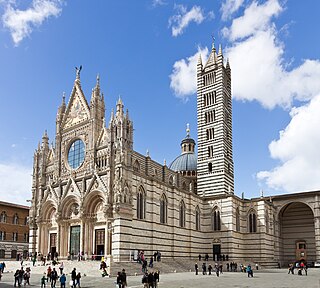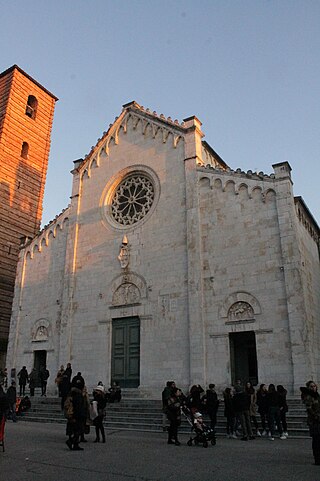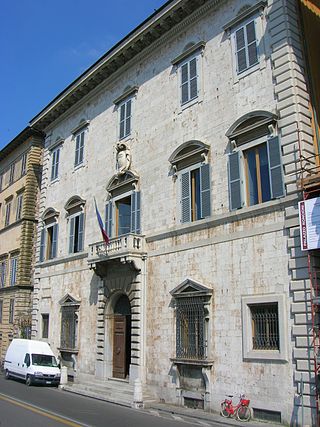
The Tribune of Galileo (Italian : Tribuna di Galileo) is a Neoclassic architectural addition, built to commemorate the famous Florentine scientist, Galileo Galilei and to house some of his scientific instruments. [1]

The Tribune of Galileo (Italian : Tribuna di Galileo) is a Neoclassic architectural addition, built to commemorate the famous Florentine scientist, Galileo Galilei and to house some of his scientific instruments. [1]
The tribune was completed in 1841 and built within the first floor of the Science Museum of La Specola in Florence. The tribune was built by orders of Leopold II (1797-1870). The House of Lorraine-Habsburg was foreign to Tuscany; and the embrace of Galileo can be seen as an attempt to co-opt local patriotism. It contains a large statue of Galileo and a series of lunettes and frescoes depicting events in scientific history relating to Florence. It once contained some of his original instruments such as his geometric and military compass, an armed loadstone, two telescopes, and the objective lens of the telescope with which Galileo discovered the four largest moons of Jupiter. The tribune is generally not open to the public. [2]
The tribune consists mainly of two rooms: a square vaulted hall, and an adjacent square room glass-metal dome. The dome allows light to shine over a marble statue of Galileo by Aristodemo Costoli. The surrounding niches have busts of famous pupils of Galileo: Benedetto Castelli, Bonaventura Cavalieri, Evangelista Torricelli, and Vincenzo Viviani. Medallions in the adjacent hall commemorate the patrons. The frescoes on the walls depict:
Ultimately, this is an odd architectural assembly. The layout has a distant resemblance to a church dome and nave; however, if so, this is a temple granting hagiographical attention to a secular scientist. It contains modern touches, such as the iron dome, but it also adheres to retardataire Neoclassic elements in the niches, arches, and columns. The arrangement suggests a tardy apology to Galileo by an aristocracy which had been slow to freely embrace his pioneering spirit of Enlightenment. It took two centuries for Florentines to honor their greatest scientist with a building. But that is not surprising, they had also been slow to bury Galileo inside a church. After his death in 1642, his interment in the main body of the Basilica of Santa Croce, next to the tombs of his father and other ancestors, was abandoned when papal authorities protested.

Santa Maria Novella is a church in Florence, Italy, situated opposite, and lending its name to, the city's main railway station. Chronologically, it is the first great basilica in Florence, and is the city's principal Dominican church.

Siena Cathedral is a medieval church in Siena, Italy, dedicated from its earliest days as a Roman Catholic Marian church, and now dedicated to the Assumption of Mary.

The Piazza dei Miracoli, formally known as Piazza del Duomo, is a walled 8.87-hectare (21.9-acre) compound in central Pisa, Tuscany, Italy, recognized as an important center of European medieval art and one of the finest architectural complexes in the world. It was all owned by the Catholic Church and is dominated by four great religious edifices: Pisa Cathedral, the Pisa Baptistery, the Leaning Tower of Pisa, and the Camposanto Monumentale. Partly paved and partly grassed, the Piazza dei Miracoli is also the site of the Ospedale Nuovo di Santo Spirito, which now houses the Sinopias Museum and the Cathedral Museum.

Vincenzo Viviani was an Italian mathematician and scientist. He was a pupil of Torricelli and Galileo.
The Accademia del Cimento, an early scientific society, was founded in Florence in 1657 by students of Galileo, Giovanni Alfonso Borelli and Vincenzo Viviani and ceased to exist about a decade later. The foundation of Academy was funded by Prince Leopoldo and Grand Duke Ferdinando II de' Medici. The tenets of the society included:

Aristodemo Costoli (1803–1871) was an Italian sculptor who spent his entire career in the city of Florence. He is also known for attempting in 1843 to clean and conserve the famed Renaissance-era sculpture David by Michelangelo; unfortunately his hydrochloric acid cleaning solution removed the stone's waxy protective coating and left the surface pitted and porous. His students included Emilio Zocchi, Girolamo Masini, Augusto Rivalta and his son Leopoldo Costoli.

Italy has a very broad and diverse architectural style, which cannot be simply classified by period or region, due to Italy's division into various small states until 1861. This has created a highly diverse and eclectic range in architectural designs. Italy is known for its considerable architectural achievements, such as the construction of aqueducts, temples and similar structures during ancient Rome, the founding of the Renaissance architectural movement in the late-14th to 16th century, and being the homeland of Palladianism, a style of construction which inspired movements such as that of Neoclassical architecture, and influenced the designs which noblemen built their country houses all over the world, notably in the United Kingdom, Australia and the United States of America during the late-17th to early 20th centuries.

Santa Maria del Carmine is a church of the Carmelite Order, in the Oltrarno district of Florence, in Tuscany, Italy. It is famous as the location of the Brancacci Chapel housing outstanding Renaissance frescoes by Masaccio and Masolino da Panicale, later finished by Filippino Lippi.

Pietro Benvenuti was an Italian neoclassical painter.

The Collegiate Church of San Martino is a collegiate church in Pietrasanta, in the region of Tuscany, Italy. It is the main church or duomo of the town. It is first mentioned in 1223, and was subsequently enlarged in 1330 and in 1387 when Pope Urban VI had a baptismal font installed in the church.

Luigi Sabatelli was an Italian painter of the Neoclassic period; active in Milan, Rome, and Florence.

Giuseppe Bezzuoli was an Italian painter of the Neoclassical and Romantic periods.

Francesco Giuseppe Antonio Diotti was an Italian painter of the Neoclassic style.

Niccola Cianfanelli was an Italian painter and restorer. He mainly painted historic and sacred subjects in a Neoclassical style.

Gasparo Martellini was an Italian painter.

The Old Fortress of Livorno is a castle in Livorno, Italy. The Old Fortress is a successor building to a medieval fort built by the city of Pisa in the location of an older keep built by Countess Matilda of Tuscany in the 11th century. The 11th century tower was incorporated inside the fort built by the Pisans. The castle has been described as a "symbol of Medicean Livorno". The fort is located at the Medicean Darsena, or old dock of the port of Livorno, built by the Medici family. The ceremony proclaiming Livorno a city took place inside the fortress on 19 March 1606.

The Palazzo Lanfranchi-Toscanelli, presently the local State Archives, is a Renaissance-style palace located on Lungarno Mediceo #30, in the city of Pisa, region of Tuscany, Italy. Since 1913 the building has housed the Archivio di Stato di Pisa.
Candido del Buono was an Italian scientific instrument maker.
Paolo del Buono (1625-1659) was an Italian experimental scientist and scientific instrument maker who studied under Gallileo.

The Palazzo degli Anziani also known as the Palazzo del Comune, della Comunitá or del Giano is a Gothic-style stone palace located in the ancient historic center of Pistoia, Tuscany, Italy. The palace served as city hall for centuries; it still belongs to the comune and now mainly houses the Museo Civico d'Arte Antica.
![]() Media related to Tribuna di Galileo at Wikimedia Commons
Media related to Tribuna di Galileo at Wikimedia Commons